Spring管理Bean-IOC-04¶
3.基于注解配置bean¶
3.1基本使用¶
3.1.1说明¶
基本说明:基于注解的方式配置bean,主要是项目开发中的组件,比如Controller,Service和Dao
组件的注解形式有:
@Component表示当前注解标识的是一个组件@Controller表示当前注解标识的是一个控制器,通常用于Servlet@Service表示当前注解标识的是一个处理业务逻辑的类,通常用于Service类@Repository表示当前注解标识的是一个持久化层的类,通常用于Dao类
3.1.2快速入门¶
应用案例:使用注解的方式来配置Controller /Service/ Repository/ Component
代码实现:
1.使用注解方式,需要引入spring-aop.jar包,该jar包位于spring/lib下
2.创建 UserAction.java、UserService.java、UserDao.java、MyComponent.java
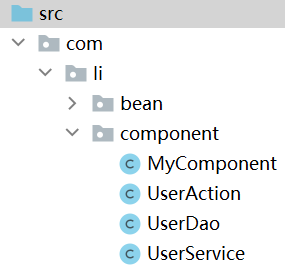
UserDao:
package com.li.component;
import org.springframework.stereotype.Repository;
/**
* @author 李
* @version 1.0
* 使用 @Repository 表示该类是一个Repository,一个持久化层的类/对象
*/
@Repository
public class UserDao {
}
UserService:
package com.li.component;
import org.springframework.stereotype.Service;
/**
* @author 李
* @version 1.0
* @Service 标识该类是一个Service类/对象
*/
@Service
public class UserService {
}
UserAction:
package com.li.component;
import org.springframework.stereotype.Controller;
/**
* @author 李
* @version 1.0
* @Controller 标识该类是一个控制器Controller,通常该类是一个Servlet
*/
@Controller
public class UserAction {
}
MyComponent:
package com.li.component;
import org.springframework.stereotype.Component;
/**
* @author 李
* @version 1.0
* @Component 用于标识该类是一个组件,是一个通用的注解
*/
@Component
public class MyComponent {
}
上面我们在类中添加了注解,但是还没有在配置文件中指定容器要扫描哪个包下的注解类
3.配置beans04.xml:
<!--配置容器要扫描的包:
1.component-scan 表示对指定的包下的类进行扫描,并创建对象到容器
2.base-package 指定要扫描的包
3.下面整个配置的含义是:当spring容器创建/初始化时,会扫描 com.li.component 包下
的所有含有四种注解(Controller/Service/Repository/Component)的类,
并将其实例化,生成对象,放入到ioc容器
-->
<context:component-scan base-package="com.li.component"/>
注意引入context命名空间
4.测试
//通过注解来配置Bean
@Test
public void setBeanByAnnotation() {
ApplicationContext ioc = new ClassPathXmlApplicationContext("beans04.xml");
System.out.println("ok");
}
在System.out.println("ok");旁打上断点,点击debug。
查看ioc对象→beanFactory→singletoObjects→table的属性。因为table属性有很多null值,为了显示方便,这里配置了IDEA不显示null值
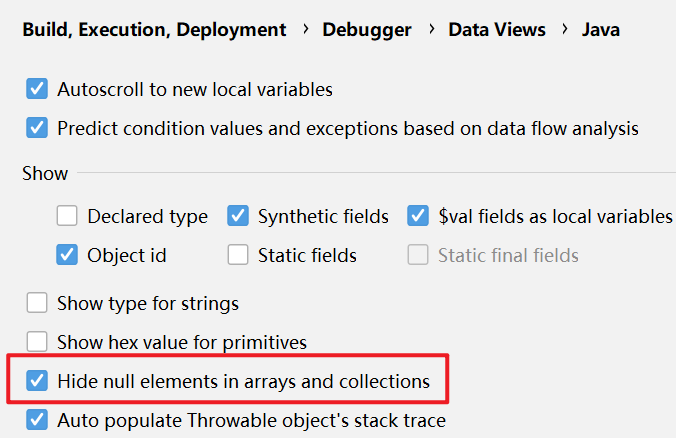
如下,spring容器中成功创建了四个对象,并且在默认情况下,按照注解方式进行扫描创建的对象,它对应的id就是它的类名(首字母小写)
其他的对象是系统自带的
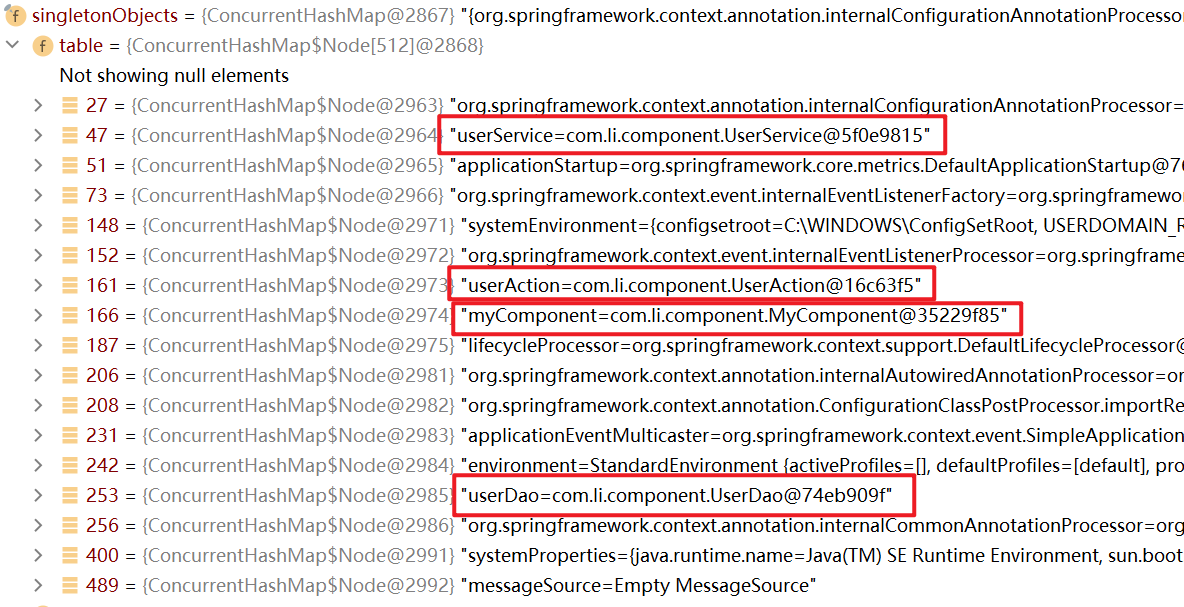
查看类型id(key)

因为配置的这四个对象是单例对象,因此可以直接通过类的类型来获取:
因为spring在创建时赋予了默认id,也可以通过id来获取
//通过注解来配置Bean
@Test
public void setBeanByAnnotation() {
ApplicationContext ioc = new ClassPathXmlApplicationContext("beans04.xml");
UserDao userDao = ioc.getBean(UserDao.class);
UserService userService = ioc.getBean(UserService.class);
UserAction userAction = ioc.getBean(UserAction.class);
MyComponent myComponent = ioc.getBean(MyComponent.class);
System.out.println("userDao=" + userDao);
System.out.println("userService=" + userService);
System.out.println("userAction=" + userAction);
System.out.println("myComponent=" + myComponent);
System.out.println("ok");
}
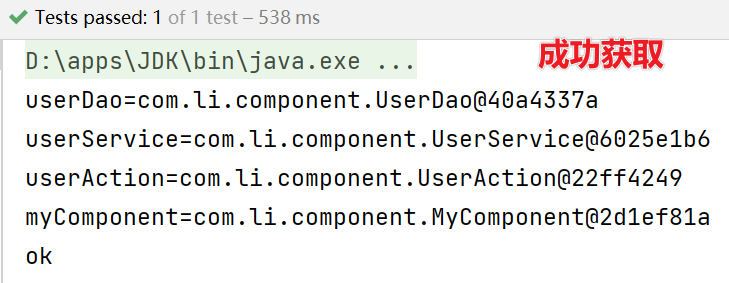
3.1.3注意事项和细节¶
-
基于注解配置bean,需要导入spring-aop.jar包
-
必须在Spring配置文件中指定“自动扫描的包”,IOC容器才能够检测到当前项目中哪些类被标识了注解
(1)在配置时注意导入context名称空间
(2)指定扫描的包时,可以使用通配符,如:com.li.component.*表示扫描com.li.component包下的类, 包括com.li.component包下的子包(递归扫描)
- Spring的IOC容器不能检测一个使用了@Controller注解的类到底是不是一个真正的控制器。注解的名称只是用于程序员自己识别当前标识的是什么组件。其他的注解@Service、@Reposity 也是一样。
也就是说,Spring的容器只要检测到注解就会生成对象,但是这个注解的含义spring不会识别,只是给程序员方便区分的
如果你只在spring容器上用,@Controller、@Service、@Reposity基本是等价的;如果你用在springmvc上面,它们是有区别的:彻底弄懂@Controller 、@Service、@Component
- 配置只扫描满足要求的类:
如下面的resource-pattern="User*.class",表示扫描指定包下以User开头的类
<context:component-scan base-package="com.li.component"
resource-pattern="User*.class" />
一般来说,想要扫描某个类只需要写上注解,不想扫描的类就不会写注解,因此上面这种写法不常使用
- 配置排除扫描的类:
如果我们希望排除某个包/子包下的某种类型的注解,可以通过exclude-filter来指定
(1)context:exclude-filter 指定要排除哪些类
(2)type 指定排除方式(annotation 表示通过注解来排除)
(3)expression 指定要排除的注解的全路径
下面的配置表示,在扫描com.li.component包下注解的类时,排除以@Service注解的类
<context:component-scan base-package="com.li.component" >
<!-- 排除哪些类, 以 annotaion注解为例(通过注解来排除) -->
<context:exclude-filter type="annotation" expression="org.springframework.stereotype.Service"/>
</context>
- 自定义规则指定扫描哪些注解类:
<!--如果我们希望通过自己的规则,来扫描包/子包下的某些注解类,可以通过include-filter
1. use-default-filters="false": 表示不使用默认的过滤/扫描机制
2. context:include-filter: 表示只是扫描指定的注解的类
3. type="annotation" 表示按照注解方式来扫描
4. expression="org.springframework.stereotype.Controller" 指定要扫描的注解的全类路径
-->
<context:component-scan base-package="com.li.component" use-default-filters="false">
<context:include-filter type="annotation" expression="org.springframework.stereotype.Service"/>
<context:include-filter type="annotation" expression="org.springframework.stereotype.Controller"/>
</context:component-scan>
-
在默认情况下,注解标识的类创建对象后,在容器中它默认对应的id就是它的类名(首字母小写)
-
也可以使用注解的value属性指定 id 值,并且 value 可以省略:
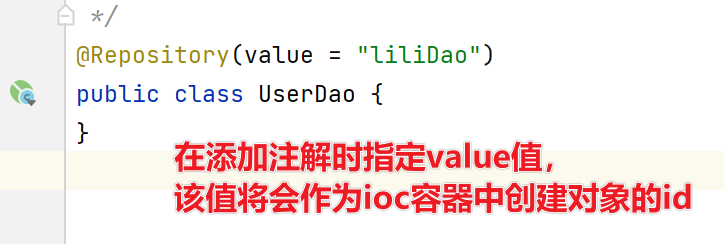

3.2手动开发-简单的Spring基于注解配置的程序¶
3.2.1需求说明¶
自己写一个简单的Spring容器,通过读取类的注解(@Component、@Controller、@Service、@Repository),将对象注入到IOC容器。即不使用Spring原生框架,我们自己使用IO+Annotation+反射+集合实现,加深对Spring注解方式开发的理解。
3.2.2思路分析¶
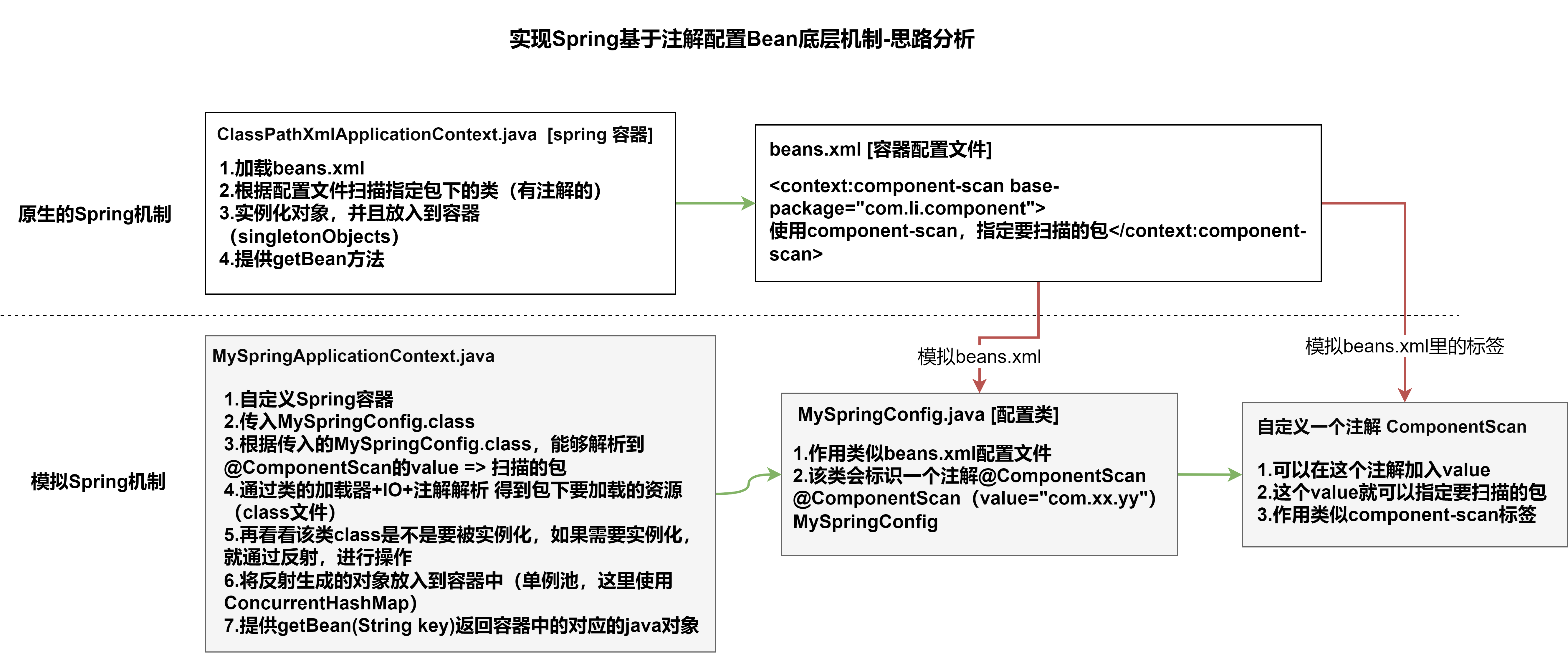
3.2.3代码实现¶
步骤一:搭建基本结构并获取扫描包
1.ComponentScan注解(模拟原生的spring注解)
package com.li.annotation;
import java.lang.annotation.ElementType;
import java.lang.annotation.Retention;
import java.lang.annotation.RetentionPolicy;
import java.lang.annotation.Target;
/**
* @author 李
* @version 1.0
* 模仿spring原生注解,自定义一个注解
* 1. @Target(ElementType.TYPE) 指定ComponentScan注解可以修饰TYPE元素
* 2. @Retention(RetentionPolicy.RUNTIME) 指定ComponentScan注解 的保留范围
* 3. String value() default ""; 表示 ComponentScan 可以传入一个value值
*/
@Target(ElementType.TYPE)
@Retention(RetentionPolicy.RUNTIME)
public @interface ComponentScan {
String value() default "";
}
2.MySpringConfig配置类(模拟Spring的xml配置文件)
package com.li.annotation;
/**
* @author 李
* @version 1.0
* 这是一个配置类,作用类似我们原生spring的容器配置文件beans.xml
*/
@ComponentScan(value = "com.li.component")
public class MySpringConfig {
}
3.MySpringApplicationContext(模拟原生的ioc容器)
package com.li.annotation;
import java.lang.annotation.Annotation;
import java.util.concurrent.ConcurrentHashMap;
/**
* @author 李
* @version 1.0
* MySpringApplicationContext 类的作用类似Spring原生的ioc容器
*/
public class MySpringApplicationContext {
private Class configClass;
//ioc中存放的就是通过反射创建的对象(基于注解方式)
private final ConcurrentHashMap<String, Object> ioc = new ConcurrentHashMap<>();
//构造器
public MySpringApplicationContext(Class configClass) {
this.configClass = configClass;
//获取要扫描的包
//1.先得到MySpringConfig配置类的注解 @ComponentScan(value = "com.li.component")
ComponentScan componentScan = (ComponentScan) this.configClass.getDeclaredAnnotation(ComponentScan.class);
//2.通过 componentScan的 value=>得到要扫描的包路径
String path = componentScan.value();
System.out.println(path);
}
}
步骤二:获取扫描包下所有.class文件
4.如下,我们现在已经获取了要扫描的包路径,接下来就是通过反射创建对象。但是反射需要的是class文件,因此我们真正需要读取的是out目录下,编译过的类.class文件
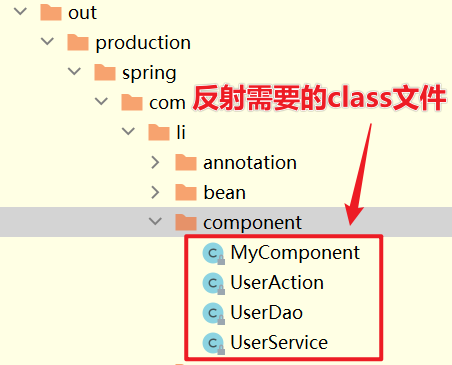
步骤三:获取全类名反射对象,并放入容器中
MySpringApplicationContext完整代码:
package com.li.annotation;
import org.springframework.stereotype.Component;
import org.springframework.stereotype.Controller;
import org.springframework.stereotype.Repository;
import org.springframework.stereotype.Service;
import org.springframework.util.StringUtils;
import java.io.File;
import java.net.URL;
import java.util.concurrent.ConcurrentHashMap;
/**
* @author 李
* @version 1.0
* MySpringApplicationContext 类的作用类似Spring原生的ioc容器
*/
public class MySpringApplicationContext {
private Class configClass;
//ioc中存放的就是通过反射创建的对象(基于注解方式)
private final ConcurrentHashMap<String, Object> ioc = new ConcurrentHashMap<>();
//构造器
public MySpringApplicationContext(Class configClass) {
this.configClass = configClass;
//##步骤一:获取要扫描的包
//1.先得到MySpringConfig配置类的注解 @ComponentScan(value = "com.li.component")
ComponentScan componentScan = (ComponentScan) this.configClass.getDeclaredAnnotation(ComponentScan.class);
//2.通过 componentScan的 value=>得到要扫描的包路径
String path = componentScan.value();
System.out.println(path);//com.li.component
//##步骤二:得到要扫描的包下的所有资源(类.class)
//1.得到类的加载器
ClassLoader classLoader = MySpringApplicationContext.class.getClassLoader();
//2.通过类的加载器获取到要扫描的包的资源 url=>类似一个路径
path = path.replace(".", "/");//将原先路径的.替换成/ ==> com/li/component
URL resource = classLoader.getResource(path);
//resource=file:/D:/IDEA-workspace/spring/out/production/spring/com/li/component
System.out.println("resource=" + resource);
//3.将要加载的资源(.class)路径下的文件进行遍历
File file = new File(resource.getFile());
if (file.isDirectory()) {
File[] files = file.listFiles();//将当前目录下的所有文件放到files数组中(这里没有实现递归)
for (File f : files) {
System.out.println("-----------");
System.out.println("AbsolutePath=" + f.getAbsolutePath());
//获取文件的绝对路径 fileAbsolutePath
//如:D:\IDEA-workspace\spring\out\production\spring\com\li\component\MyComponent.class
String fileAbsolutePath = f.getAbsolutePath();
//这里我们只处理.class文件
if (fileAbsolutePath.endsWith(".class")) {
//##步骤三:获取全类名反射对象,并放入容器中
//将其转变为 com.li.component.MyComponent.class 形式
//1.先获取到类名
String className = fileAbsolutePath.substring(
fileAbsolutePath.lastIndexOf("\\") + 1,
fileAbsolutePath.indexOf(".class"));
//System.out.println("className=" + className);
//2.获取类的完整路径(全类名)
// path.replace("/", ".") => com.li.component
String classFullName = path.replace("/", ".") + "." + className;
System.out.println("classFullName=" + classFullName);
//3.判断该class文件是否要注入到容器中(该类是不是有注解)
try {
/*
得到该类的Class对象:
(1)Class.forName(className) 可以反射加载类
(2)classLoader.loadClass(className)也可以反射类的Class
主要区别是:(1)的方式会调用该类的静态方法,(2)的方法不会
*/
//因为这里只是要判断该类有没有注解,因此使用比较轻量级的方式
Class<?> aClass = classLoader.loadClass(classFullName);
//判断该类是否有特定注解
if (aClass.isAnnotationPresent(Component.class) ||
aClass.isAnnotationPresent(Controller.class) ||
aClass.isAnnotationPresent(Service.class) ||
aClass.isAnnotationPresent(Repository.class)) {
//反射对象并放入到容器中
//使用完整反射方法Class.forName
Class<?> clazz = Class.forName(classFullName);
Object instance = clazz.newInstance();
//放入到容器中
//默认情况下key为类名(首字符小写)
//StringUtils.uncapitalize():将字符串首字母小写
ioc.put(StringUtils.uncapitalize(className), instance);
}
} catch (Exception e) {
e.printStackTrace();
}
}
}
}
}
//编写方法,返回容器对象
public Object getBean(String name) {
return ioc.get(name);
}
}
5.进行测试:
package com.li.annotation;
import com.li.component.MyComponent;
import com.li.component.UserAction;
import com.li.component.UserDao;
import com.li.component.UserService;
/**
* @author 李
* @version 1.0
*/
public class MySpringApplicationContextTest {
public static void main(String[] args) {
MySpringApplicationContext ioc = new MySpringApplicationContext(MySpringConfig.class);
UserAction userAction = (UserAction) ioc.getBean("userAction");
System.out.println("userAction=" + userAction);
MyComponent myComponent = (MyComponent) ioc.getBean("myComponent");
System.out.println("myComponent=" + myComponent);
UserDao userDao = (UserDao) ioc.getBean("userDao");
System.out.println("userDao=" + userDao);
UserService userService = (UserService) ioc.getBean("userService");
System.out.println("userService=" + userService);
System.out.println("ok");
}
}
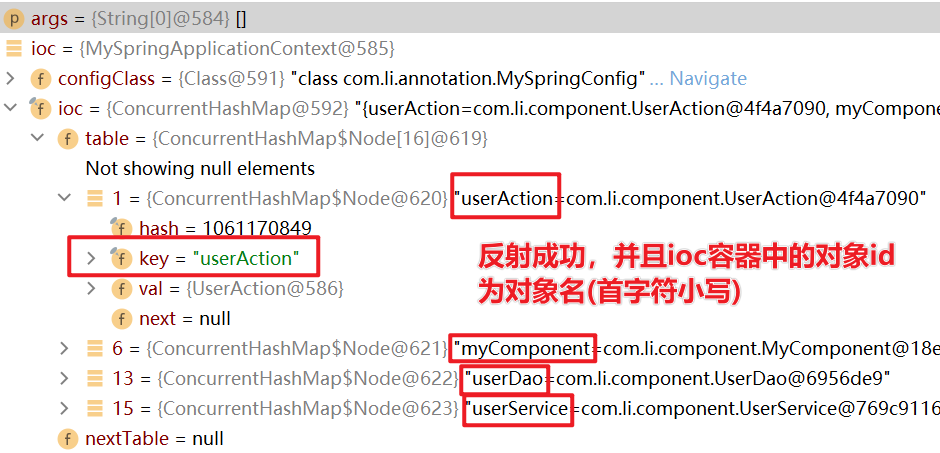
3.2.4注意事项和细节说明¶
上述代码默认将反射类的类名首字符小写后,放入到ioc容器中。但是在原生spring中我们可以在注解的value中指定对象key值。
因此上述代码的逻辑可以优化为:进行反射之前,先判断注解有没有指定value值,如果有,将其作为反射的对象的key,放入到ioc容器中。
//这里以Component注解为例,其他注解的逻辑一致
if (aClass.isAnnotationPresent(Component.class)) {
//获取该注解
Component component = aClass.getDeclaredAnnotation(Component.class);
//获取该注解的value值
String id = component.value();
if (!"".endsWith(id)) {
className = id;
}
}